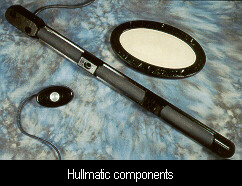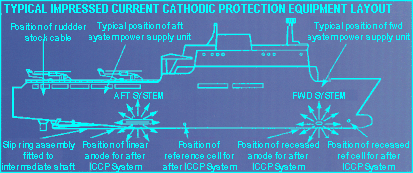| 14)Impressed
Current And Anti-Fouling Systems
陰極防蝕系統
Impressed Current Cathodic Protection System (ICCP)
| Photo
View |
Details
& Description |
|
 |
 |
 |
Hullmatic
Impressed Current Cathodic Protection System (ICCP)
The Wilson Taylor 'Hullmatic' ICCP system is designed to prevent
the external corrosion on underwater steel. Applications are
suited for ships, offshore rigs, semi submersible and other
marine structures.
ICCP systems were developed originally to protect the underwater
external hulls of large tankers and bulk carriers, which could
not be adequately protected by sacrificial anode systems. ICCP
systems are so successful that they are in common use on all
ranges of ships.
Each 'Hullmatic' ICCP system fundamentally comprises of four
main parts:-
1. Titanium anodes designed to last at least 20 years - either
linear surface mounted or recessed.
2. Zinc or sliver/silver chloride reference electrodes - either
surface or recessed.
3. Propeller shaft bonding slip ring and rudder stock cable
4. Automated control panel - rated from 100 amps to 800 amps
ANODES
All 'Hullmatic' anodes conduct D.C. protective current into
the seawater to maintain the hull potential at the correct level
to prevent corrosion occurring at areas when the paint has become
damaged. The anodes are constructed from titanium elements coated
with either platinum or mixed metal oxide. The elements are
encapsulated in a tough chlorine resistant resin carrier. Anodes
are available with capacity from 50 amps to 200 amps.
REFERENCE ELECTRODES
The reference electrodes are designed to give a stable reference
against which the hull to sea potential can be measured.
PROPELLER & RUDDER BONDING
To allow the protection for the propeller a high content silver
alloy band is attached around the shaft. Contact between the
shaft and hull is by way of silver graphite brushes.
Similarly, the rudder protection is ensured by the fitting of
a bonding cable, which is attached to the rudderstock and hull.
POWER SUPPLY UNITS
The 'Hullmatic' control unit is a thyristor-based unit with
a computer controller available with either analogue or digital
displays. The unit is in wide use today and recognised for its
reliability and robust quality in often harsh environments.
|
 |
WILSON TAYLOR
海生物防蝕系統 MGPS
| Photo
View |
Details
& Description |
|
|
 |
 |
 |
 |
'Intakematic'
Marine Growth Anti-fouling Protection System
The Wilson Taylor Marine Growth Protection System (MGPS) is
designed to prevent marine growth from accumulating and reducing
corrosion within sea water pipes associated with seawater cooling
systems.
Marine growth is the result of settlement of the larvae and
subsequent growth of the shell type life such as Acorn Barnacle,
Gooseneck Barnacle etc. In extreme cases fouling can become
so serious as to completely obstruct pipes preventing the flow
of seawater through them. This can lead to complications with
cooling water flow and reduction of machinery efficiency, corrosion
and loss of speed - a serious situation especially when charters
demand a minimum speed.
The Wilson Taylor 'Intakematic' system is electrolytic in action
using copper and aluminium or iron anodes installed usually
in the sea chests which are fed by a low dc current from a constant
current control panel. The subsequent release of copper ions
is sufficient to deter settlement of larvae. The required level
of copper to prevent fouling is extremely small and measured
in micro grams per litre of seawater.
The 'Intakematic' system for the prevention of fouling has
the following advantages:-
• Simple Installation
• Operates automatically
• Minimum supervision required
• Complete protection against fouling
• Reduction in corrosion
• Minimal power requirement
Each Wilson Taylor System is designed to suit each vessel
and takes into account the following factors:-
1. Quantity of seawater to be treated (flow rate) in cubic meters
per hour.
2. Required life of anodes (usually dry docking interval for
sea chest mounted anodes).
3. Material of pipe works in the sea water system.
|
|

